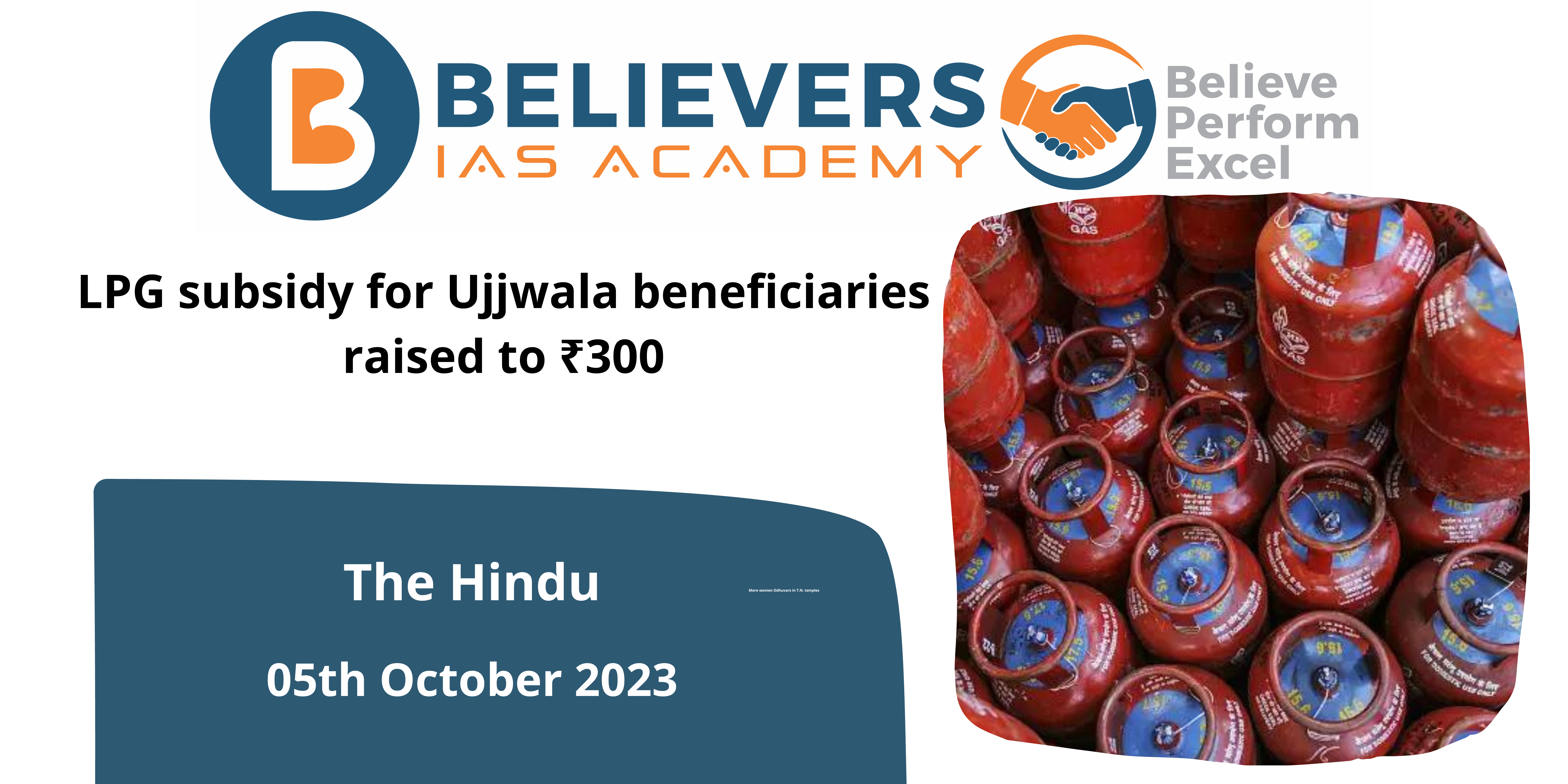LPG subsidy for Ujjwala beneficiaries raised to ₹300
Context
The Union Cabinet increased the subsidy on LPG cylinders under the Ujjwala scheme to 300 from 200 per cylinder on Wednesday, ahead of Assembly elections in five states.
What is the Ujjwala Scheme?
- The Indian government introduced the Pradhan Mantri Ujjwala Yojana (PMUY) in 2016, a social welfare scheme that supports Prime Minister Narendra Modi’s objective of a smoke-free rural India. The initiative was launched to provide discounted LPG connections to the entire country by 2019.
- The scheme was anticipated to help 80 million families (up from 50 million previously), with a focus on those living below the poverty line (BPL). It will aid in increasing LPG usage while reducing air pollution, deforestation, and health problems among populations.
What is the requirement for the Ujjwala scheme?
- LPG connections in India are concentrated in urban and semi-urban areas, with the majority of connections in middle and higher-middle-class families. Due to limited access to LPG, low-income households frequently use fossil fuels such as coal, kerosene, and timber as primary sources of cooking; however, these sources are largely associated with serious health hazards such as indoor air pollution, which causes acute respiratory illnesses, and pulmonary and lung diseases.
- According to the WHO, the use of filthy cooking fuels is responsible for 5 lakh deaths in India, with the bulk of deaths caused by noncommunicable diseases such as lung cancer and chronic obstructive pulmonary disease.
- The government’s PMUY scheme intends to increase the reach of LPG connections to low-income and below-poverty-line (BPL) homes, reducing their reliance on fossil fuels. Apart from guaranteeing universal coverage of LPG connections throughout the country, this initiative also empowers women and improves their health by decreasing drudgery and cooking time. It will help to create jobs for rural youths in the cooking gas supply chain management.
What are the objectives of the scheme?
- To emancipate women and protect their well-being.
- To lower the health risks connected with the use of impure fossil fuels and other cooking fuels.
- To reduce interior air pollution caused by fossil fuel combustion, which causes respiratory difficulties.
- To prevent the pollution of the environment caused by the widespread use of impure culinary fuels.
What are the features of the scheme?
- Provide Rs. 1,600 in financial assistance to BPL households for each LPG connection.
- Provide interest-free loans to oil marketing companies for the purchase of stoves and refills.
- The government will pay the Rs. 1,600 administrative fee for the connection, which includes a cylinder, pressure regulator, handbook, and safety hose.
- As sanctioned by the Cabinet Committee on Economic Affairs, Pradhan Mantri Ujjwala Yojana (PMUY) participants would receive a subsidy of Rs. 200 for each 14.2 kg cylinder for up to 12 refills per year in 2023-2024.
What are the recent changes made to the scheme?
- Increase in Subsidy: The Union Cabinet has approved an increase in the subsidy granted on LPG cylinders distributed under the Ujjwala scheme. The cylinder subsidy has been increased from Rs200 to Rs300.
- Cylinder Cost Reduction: The cost of a 14.2-kg LPG cylinder under the Ujjwala plan has fallen as a result of the subsidy increase. It will now be priced at Rs603, down from Rs703 per cylinder previously.
What are the benefits of the Ujjwala scheme?
- Access to Clean Cooking Fuel: The major goal of the Ujjwala scheme is to enable households that previously relied on archaic and polluting cooking methods such as wood, coal, or kerosene access to clean cooking fuel, namely LPG (liquefied petroleum gas). This switch to LPG helps to reduce indoor air pollution, which improves family health and well-being.
- Health Advantages: By substituting LPG for traditional cooking fuels, the Ujjwala scheme helps to reduce respiratory ailments and health difficulties caused by indoor air pollution. This is especially useful for women and children, who are particularly vulnerable to the negative consequences of traditional cooking methods.
- Women Empowerment: The scheme aims to empower women by providing them with LPG connections in their names. This not only promotes gender equality but also provides women influence over home cooking decisions and relieves them of the arduous task of collecting firewood or other conventional fuels.
- Financial Assistance: Ujjwala offers financial help to eligible individuals to cover the cost of the LPG connection. The financial aid covers the cylinder security deposit, pressure regulator, and administrative charges for the connection. This financial assistance makes LPG more affordable for economically disadvantaged households.
- Subsidized Refills: Ujjwala scheme beneficiaries also receive LPG refill subsidies. The government offers a subsidy to cut the continuous cost of purchasing LPG cylinders, making them more affordable for households.
What are the challenges faced by the Scheme?
- Identification of poor families: The most difficult difficulty in allocating free LPG connections was the lack of authentic data that could help identify impoverished households with 100% accuracy. Even though the government used SECC-2011 data, it was stated that many worthy households were left out of the fieldwork.
- Misuse of SECC data: It was discovered that a few affluent families were also identified as BPL households in the SECC-2011 data, making it difficult to confirm the legitimacy of all data in the SECC database.
- Beneficiaries’ safety awareness: Because the majority of beneficiaries were poor and illiterate, they had little knowledge of the safety standards for cooking on an LPG stove.
Conclusion
In summary, the Ujjwala scheme provides numerous benefits, including improved health, women’s empowerment, financial help, environmental benefits, and economic benefits. It is critical in enhancing the overall quality of life for economically disadvantaged Indian households.




